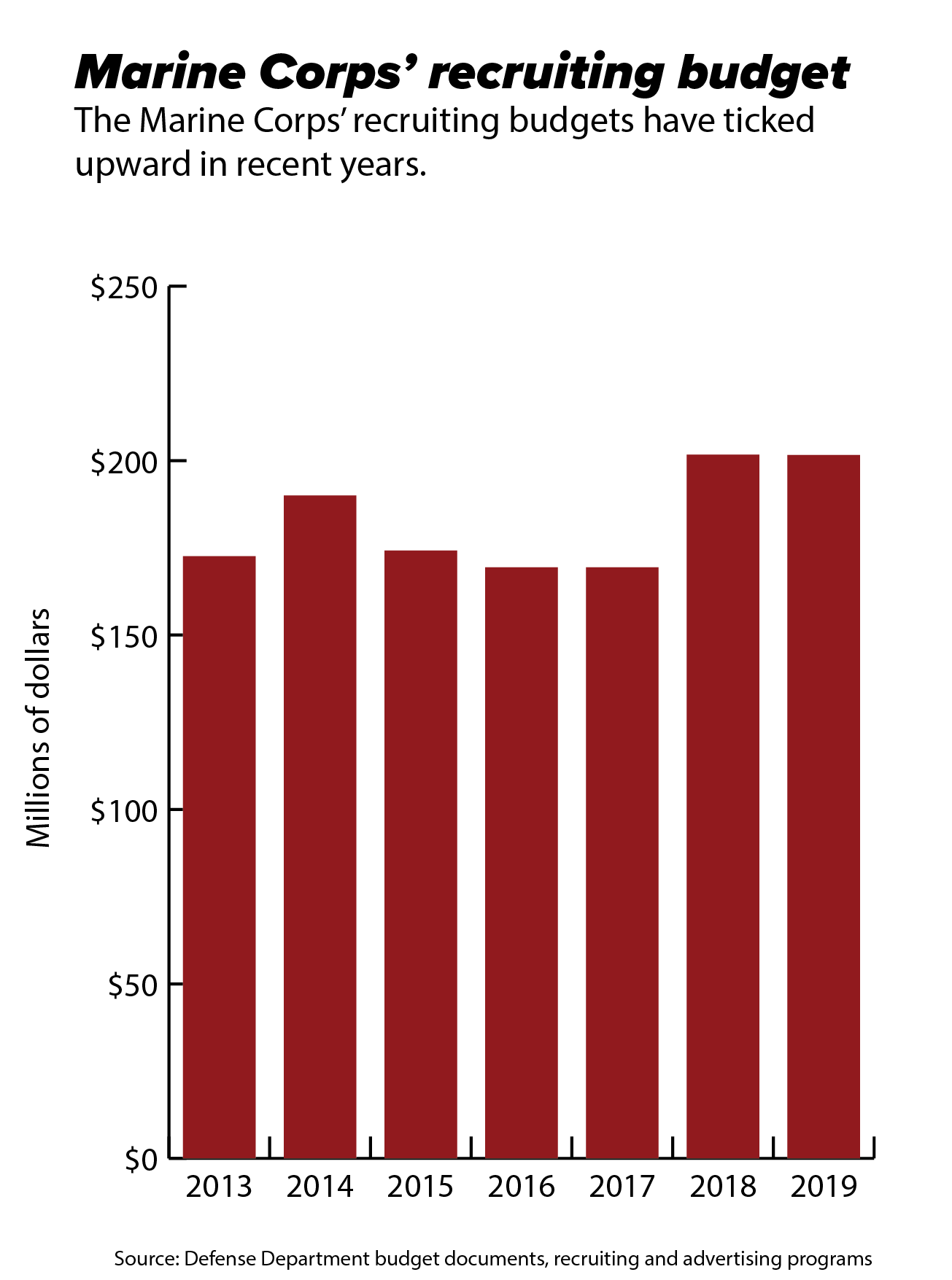A Marine recruiting poster from the 1970s captured the spirit of the Corps' attitude and pitched what would entice young Americans to join the Corps for generations: “We don’t promise you a rose garden."
The Corps historically has dangled fewer cash bonuses and offered less incentives than the other services to drive its recruitment efforts.
For the past six years, the Corps hasn’t offered more than a $9,000 enlistment bonus. There’s even a whopping $5,000 bonus for young motivators who sign up for six-year infantry contracts — that’s less than a grand a year ― and after taxes, the pie slice gets even smaller.
But, as with most years, the Marines again hit its recruiting goals only promising future Marines misery in boot camp. That, and the fun of living in austere environments around the globe, the transformation process into a Marine and chance to help win the nation’s battles, in a new recruiting campaign dubbed “Battles Won."
However, to meet ascension goals and fill the holes of first-termers who exit the Corps, the Marines need to shuffle over 30,000 new recruits every year onto its famous yellow footprints, which herald the beginning of a recruit’s transformation into a Marine aboard the recruit depots.
It’s an effort now inundated with a slew of new challenges and a young recruitment pool that views the Corps in its least popular light in nearly a decade, according to Defense Department data.
Overall, interest in joining the military is waning. The most recent internal Defense Department surveys, conducted in late 2017, show the percentage of young people who say they will likely join the military is at 11 percent ― the lowest point in nearly 10 years.
When asked about specific services, surveys show the Marine Corps is the least popular among young people — only 5 percent of young people say they will likely join the Marine Corps, compared with 7 percent for the other three Defense Department services.
“We face a challenging recruiting environment in which our Marine recruiters have to overcome the fact that to begin with, 75 percent of age-qualified youth are unqualified for service due to medical, moral or educational issues," said Gunnery Sgt. Justin Kronenberg, a spokesman for Marine Corps Recruiting Command.
The high percentage of Americans unfit for military service is alarming for Marine Corps officials.
“That should scare you,” Gen. Robert B. Neller, the commandant of the Marine Corps, told reporters at a media roundtable event in October.
“Additionally, market research shows that more than 90 percent of America’s youth are disinterested in military service and fewer than 17 percent of parents of those in our target demographic have served in the military, which means our recruiters have to work hard to bridge the so-called civil-military gap,” he said.
To make ends meet, the Corps has approved more waivers in recent years.
In 2017, Marine recruiters handed out 5,133 waivers, up about 27 percent from two years earlier, when the Corps granted 4,028 waivers in 2015. The majority of the waivers were for medical conditions and a small percentage were for misconduct, according to Marine Corps data.
But the Corps says its waiver numbers are relatively modest.
“Some improvements were made to the medical screening process that made it more efficient and allowed more applicants' medical history to be individually considered by the Naval Bureau of Medicine and Surgery,” Kronenberg told Marine Corps Times.
The additional scrutiny on the screening process has meant that some people with previously “disqualifying” conditions, like a healed broken bone or acne, could be cleared to join, which has resulted in a slight uptick in waivers, Kronenberg explained.
The Corps also has embarked on an aggressive media blitz to entice a diverse demographic, to include more women and Americans with vital skills like cyber to join its rank and file.

The Commandant of the Marine Corps Gen. Robert B. Neller has oft repeated a goal of the Corps to grow its ranks to nearly 10 percent women.
Couple that with Neller’s desire to retool a force once stuck in the quagmire of counterinsurgency conflict, it’s a pretty big hill for the Corps to climb.
The Corps simply wants it all: more women, smarter Marines and future grunts that can operate in mission sets once the purview of the military’s special operations community.
But the recruitment pool to obtain that talent is dwindling, and the Corps has to compete with other services all in the same arena.
“The strategy has not changed,” Kronenberg said, “Though some of the tactics employed have evolved.”
“We first seek those who share the desire to serve our nation, communities and Corps ― those who want to become U.S. Marines. The aggressive commitment we demand from applicants is to the Corps rather than to a job,” he said.
“Battle’s Won” is the current Marine Corps marketing pitch.
It is focused on the "irreducible essence of the Marines, individually and collectively, which is the willingness to engage and the determination to defeat an opposing force ― whether personal or on behalf of our nation and its communities,” Kronenberg said.
To grow the number of women in the ranks, the Corps took a spin on its “Battle’s Won” campaign in 2017 with “Battle Up,” which was the first commercial to feature a female protagonist.
“These commercials feature women in a more authentic and representative manner alongside their male counterparts and clearly communicates who we are as Marines, what we do in support of our nation’s interests, and why it should be important and aspirational to our country’s citizens,” said Jim Edwards, a spokesman with Marine Corps Recruiting Command.
But the Corps has also embarked on innovative “targeted marketing engagements” like the “Hack the Corps” event recently held in Las Vegas to help recruit top tier talent from high-demand skillsets.
The event also helps the Corps mitigate some cyber vulnerabilities with its public facing sites.
But Kronenberg notes that one major change is afoot.
Since October, “all applicants will be tested for potential in offensive and defensive cyber operation skills,” Kronenberg said.
“Service in the Marine Corps is an aspirational, viable option for those few who share our fighting spirit and are mentally, morally and medically qualified and young men and women interested in service to the nation should visit Marines.com to request more information,” Kronenberg said.
But if the Corps can’t continue to stack its force with skilled young Americans “it really won’t matter,” Neller warned.
Human capital is the “critically capability” that the military has to be able to sustain, he added.

Shawn Snow is the senior reporter for Marine Corps Times and a Marine Corps veteran.
